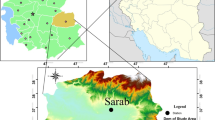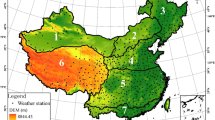Abstract
Drought modelling is an important issue because it is required for curbing or mitigating its effects, alerting the people to the its consequences, and water resources planning. This study investigates the capability of a deep learning method, long short-term memory (LSTM), in forecasting drought calculated from monthly rainfall data obtained from four stations of Iran. The outcomes of LSTM compared with extra-trees (ET), vector autoregressive approach (VAR) and multivariate adaptive regression spline (MARS) methods in forecasting four drought indices, SPI-3, SPI-6, SPI-9 and SPI-12, taking into account numerical criteria, root-mean-square errors (RMSE), Nash–Sutcliffe efficiency and correlation coefficient together with the visual methods, time variation graphs, scatter plots and Taylor diagrams. The overall results showed that the LSTM method performed superior to the ET, VAR and MARS in forecasting drought based on SPI-3, SPI-6, SPI-9 and SPI-12. The RMSE of ET, VAR and MARS was improved by about 17.1%, 12.8% and 9.6% for SPI-3, by 10.5%, 6.2% and 5% for SPI-6, by 7.3%, 4.1% and 6.2% for SPI-9 and by 22.2%, 27% and 10.6% for SPI-12 using LSTM. The MARS method was ranked as the second best, while the ET provided the worst results in forecasting drought based on SPI.



















Similar content being viewed by others
References
Adamowski J, FungChan H, Prasher SO, Ozga-Zielinski B, Sliusarieva A (2012) Comparison of multiple linear and nonlinear regression, autoregressive integrated moving average, artificial neural network, and wavelet artificial neural network methods for urban water demand forecasting in Montreal, Canada. Water Resour Res 48:W01528. https://doi.org/10.1029/2010WR009945
Adnan RM, Liang Z, Parmar KS, Soni K, Kisi O (2020) Modeling monthly streamflow in mountainous basin by MARS, GMDHNN and DENFIS using hydro-climatic data. Neural Comput Appl. https://doi.org/10.1007/s00521-020-05164
Alizamir M, Kim S, Kisi O, Zounemat-Kermani M (2020) Deep echo state network: a novel machine learning approach to model dew point temperature using meteorological variables. Hydrol Sci J. https://doi.org/10.1080/02626667.2020.1735639
Alizamir, M., S. Kim, Kisi, O. and Zounemat-Kermani, M. 2020b. A comparative study of several machine learning based non-linear regression methods in estimating solar radiation: Case studies of the USA and Turkey regions. Energy: 117239.
Alizamir M, Kim S et al (2020) Kernel extreme learning machine: an efficient model for estimating daily dew point temperature using weather data. Water 12(9):2600
Arvind Singh T, Bhawana N, Lokendra S (2015) Drought spells identification with indices for Almora district of Uttarakhand, India. Am Int J Res Sci Technol Eng Math 12(1):2328–3491
Belayneh A, Adamowski J (2013) Drought forecasting using new machine learning methods. J Water Land Dev 18:3–12
Belayneh A, Adamowski J, Khalil B (2016) Short-term SPI drought forecasting in the Awash River Basin in Ethiopia using wavelet transforms and machine learning methods. Sustain Water Resour Manag 2:87. https://doi.org/10.1007/s40899-015-0040-5
Bishop CM (1995) Neural networks for pattern recognition. Oxford University Press, Oxford, p 482
Box GEP, Jenkins GM, Reinsel GC (1994) Time series analysis, forecasting and control. Prentice Hall, Englewood Cliffs, NJ, USA
El-Shafie A, Noureldin A, Taha M, Hussain A (2011) Dynamic versus static neural network model for rainfall forecasting at Klang River Basin. Malaysia Hydrol Earth Syst Sci Discuss 8:6489–6532
Fan H, Jiang M, Xu L, Zhu H, Cheng J, Jiang J (2020) Comparison of long short term memory networks and the hydrological model in runoff simulation. Water 12:175. https://doi.org/10.3390/w12010175
Farahmand A, AghaKouchak A (2015) A generalized framework for deriving nonparametric standardized drought indicators. Adv Water Resour 76:140–145
Fathian F, Fakheri-Fard A, Ouarda TBMJ, Dinpashoh YS, Mousavi Nadoushani S (2019) Multiple streamflow time series modeling using VAR–MGARCH approach. Stoch Env Res Risk Assess. https://doi.org/10.1007/s00477-019-01651-9
Galelli S, Castelletti A (2013) Assessing the predictive capability of randomized tree-based ensembles in streamflow modelling. Hydrol Earth Syst Sci 17:2669–2684
Gers FA, Schmidhuber J, Cummins F (2000) Learning to forget: continual prediction with LSTM. Neural Comput 12(10):2451–2471
Gourabi BR (2010) The recognition of drought with DRI and SIAP method and its effects on rice yield and water surface in Shaft, Gilan, south Western of Caspian Sea. Aust J Basic Appl Sci 4(9):4374–4378
Graves A, Liwicki M, Fernández S, Bertolami R, Bunke H, Schmidhuber J (2008) A novel connectionist system for unconstrained handwriting recognition. IEEE Trans Pattern Anal Mach Intell 31(5):855–868
Geurts P, Ernst D, Wehenkel L (2006) Extremely randomized trees. Mach Learn 63:3–42. https://doi.org/10.1007/s10994-006-6226-1
Hosseini-Moghari SM, Araghinejad S, Azarnivand A (2017) Drought forecasting using data-driven methods and an evolutionary algorithm. Model Earth Syst Environ 3(4):1675–1689
Jalalkamali A, Moradi M, Moradi N (2015) Application of several artificial intelligence models and ARIMAX model for forecasting drought using the Standardized Precipitation Index. Int J Environ Sci Technol 12(4):1201–1210
Karavitis CA, Alexandris S, Tsesmelis DE, Athanasopoulos G (2011) Application of the standardized precipitation index (SPI) in Greece. Water 3:787–805
Keyantash JA, Dracup JA (2004) An aggregate drought index: assessing drought severity based on fluctuations in the hydrologic cycle and surface water storage. Water Resour Res 40(9)
Khadr M (2016) Forecasting of meteorological drought using Hidden Markov Model (case study: The upper Blue Nile river basin, Ethiopia). Ain Shams Eng J 7:47–56
Khan MMH, Muhammad NS, El-Shafie A (2018) Wavelet-ANN versus ANN-based model for hydrometeorological drought forecasting. Water 10:998
Khashei M, Bijari M (2011) A novel hybridization of artificial neural networks and ARIMA models for time series forecasting. Appl Soft Comput 11(2):2664–2675. https://doi.org/10.1016/j.asoc.2010.10.015
Kim TW, Valdes JB (2003) Nonlinear model for drought forecasting based on a conjunction of wavelet transforms and neural networks. J Hydrol Eng 6:319–328
Kisi O (2011) Wavelet regression model as an alternative to neural networks for river stage forecasting. Water Resour Manag 25:579–600
Kisi O, Docheshmeh Gorgij A, Zounemat-Kermani M, Mahdavi-Meymand A, Kim S (2019) Drought forecasting using novel heuristic methods in a semi-arid environment. J Hydrol 578:124053
Lloyd-Hughes B, Saunders MA (2002) A drought climatology for Europe. Int J Climatol 22:1571–1592
McKee TB, Doesken NJ, Kleist J (1993) The relationship of drought frequency and duration to time scales. In: Proceedings of the 8th conference on applied climatology, Vol 17, No. 22, pp. 179–183
Mishra AK, Desai VR (2006) Drought forecasting using stochastic models. Stoch Env Res Risk Assess 19(5):326–339
Morid S, Smakhtin V, Moghaddasi M (2006) Comparison of seven meteorological indices for drought monitoring in Iran. Int J Climatol 26:971–985
Morid S, Smakhtin V, Moghaddasi M (2006) Comparison of seven meteorological indices for drought monitoring in Iran. Int J Climatol 26(7):971–985
Nourani V, Baghanam AH, Adamowski J, Kisi O (2014) Applications of hybrid wavelet-artificial intelligence models in hydrology: a review. J Hydrol 514:358–377. https://doi.org/10.1016/j.jhydrol.2014.03.057
Peng T, Zhou J, Zhang C, Fu W (2017) Streamflow forecasting using empirical wavelet transform and artificial neural networks. Water 9:406
Quilty J, Adamowski J, Boucher M-A (2019) A stochastic data-driven ensemble forecasting framework for water resources: a case study using ensemble members derived from a database of deterministic wavelet-based models. Water Resour Res 55:175–202. https://doi.org/10.1029/2018WR023205
Remesan R, Shamim MA, Han D, Mathew J (2009) Runoff prediction using an integrated hybrid modelling scheme. J Hydrol 372:48–60
Sak H, Senior A, and Beaufays F (2014) Long short-term memory based recurrent neural network architectures for large vocabulary speech recognition. arXiv preprint arXiv:1402.1128
Shabri A (2015) A hybrid model for stream flow forecasting using wavelet and least Squares support vector machines. Jurnal Teknologi 73:89–96
Singh VP (1994) Elementary hydrology. Prentice Hall of India, New Delhi, India
Tayyab M, Zhoua J, Adnana R, Zenga X (2017) Application of artificial intelligence method coupled with discrete wavelet transform method. Procedia Comput Sci 107:212–217. https://doi.org/10.1016/j.procs.2017.03.081
Tsakiris G, Vangelis H (2004) Towards a drought watch system based on spatial SPI. Water Resour Manag 18(1):1–12
Van Loon AF, Van Lanen HAJ (2013) Making the distinction between water scarcity and drought using an observation-modeling framework. Water Resour Res 49:1483–1502. https://doi.org/10.1002/wrcr.20147
Vicente-Serrano SM, Beguería S, López-Moreno JI (2010) A multiscalar drought index sensitive to global warming: the standardized precipitation evapotranspiration index. J Clim 23(7):1696–1718
Sanusi W, Jemain AA, Zin WZW, Zahari M (2014) The drought characteristics using the first-order homogeneous Markov chain of monthly rainfall data in Peninsular Malaysia. Water Resour Manag 29:1523–1539
Zhang Y, Li W, Chen Q, Pu X, Xiang L (2017) Multi-models for SPI drought forecasting in the north of Haihe River Basin, China. Stoch Environ Res Risk Assess 31:2471–2181
Author information
Authors and Affiliations
Corresponding authors
Ethics declarations
Conflict of interest
The authors declare that they have no conflict of interest.
Additional information
Publisher's Note
Springer Nature remains neutral with regard to jurisdictional claims in published maps and institutional affiliations.
Rights and permissions
About this article
Cite this article
Docheshmeh Gorgij, A., Alizamir, M., Kisi, O. et al. Drought modelling by standard precipitation index (SPI) in a semi-arid climate using deep learning method: long short-term memory. Neural Comput & Applic 34, 2425–2442 (2022). https://doi.org/10.1007/s00521-021-06505-6
Received:
Accepted:
Published:
Issue Date:
DOI: https://doi.org/10.1007/s00521-021-06505-6




